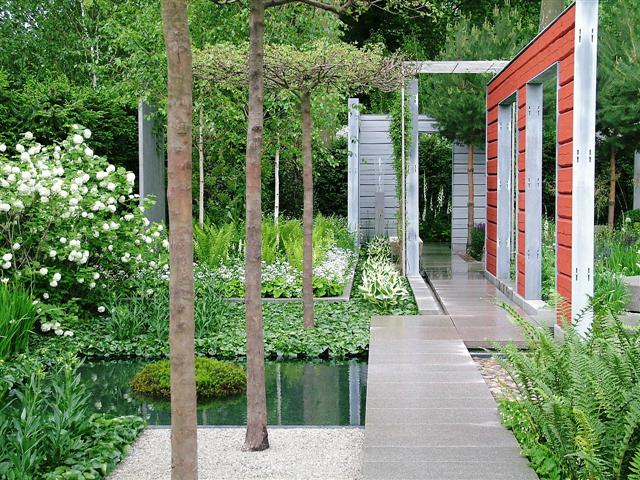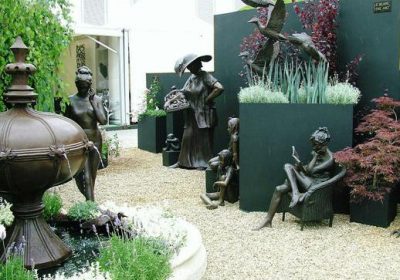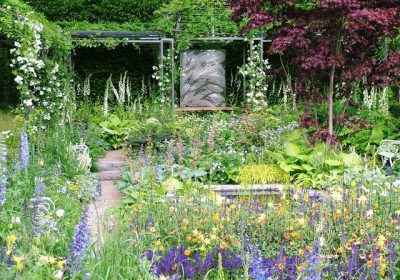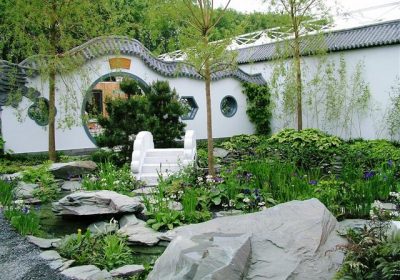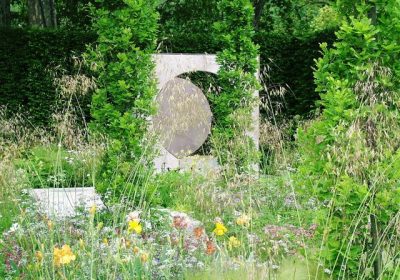2007 is the tercentenary of the Swedish botanist, scientist and explorer, Carl Linnaeus. His life and work will be celebrated through numerous activities and exhibitions worldwide. His passion for the natural world will be celebrated across the UK, specifically at the RHS Chelsea Flower Show 2007 with two events, the first of which has been commissioned by the National Tercentenary Committee in Stockholm in cooperation with the Embassy of Sweden and The Swedish Institute. A ‘Tribute to Linnaeus’ is a show garden – designed by eminent Swedish landscape architect Ulf Nordfjell.
The second event, organised by the Linnean Society of London is a display in the floral marquee entitled Linnaeus’ Legacy – 300 years of naming nature. The theme of the exhibit will be the continuing legacy begun by Linnaeus – naming of plants and its importance and relevance in today’s world.
The show garden is a contemporary design. Its composition, materials chosen and plant selections all pay tribute to particular aspects of Linnaeus and his native landscape. Many of the themes explored in the garden design are deeply rooted in the cultural heritage and identity of Sweden. The garden design celebrates both a modern interpretation and traditional values.
Hedges of Picea, a traditional hedging plant, give basic structure and enclosure to the garden. The primary tree species used are Pine and Birch, both iconic to the Swedish landscape. Malus, cultivated by Linnaeus in his botanic gardens, is used with flat cut crowns to compliment the character of the Pine and Birch.
The plants used in the garden are a mix of those grown or cultivated by Linnaeus together with common plants grown in Swedish gardens and more unusual ones such as euphorbias and new ferns. Those plants used in the garden which were originally planted by Linnaeus in his own gardens at Hammarby outside Uppsala and are still growing there today include; Lilium martagon ‘Album’, Asarum eruopaeum and Jovibarba globifera (Semperivium soboliferum).
Several other plants chosen for the garden are known for being cultivated by Linnaeus at his botanical garden in Uppsala, these include; Lingustrum vulgaris, Viburnum opulus ‘Roseum’, Malus, Fritilaria melagris. Astrantia major, Digitalis purpurea, Iris sibirica, Osmunda regalis and of course the trademark Linnaea borealis. the use of wild species which can be traced back to Linnaeus days include; Vaccinium vitis-idaea, Deschampsia cespitosa and Fragaria vesca.
The garden is partially divided diagonally by perforated timber walls. The openings within the walls frame more precise and specific views within the garden. Encouraging different ways of looking into the garden reflects the enduring curiosity of Linnaeus and his scientific approach to nature. The subdivisions made by the timber walls also define different plant micro climates for shady, sunny, drought or moisture loving plant species.
The walls combing historical and modern construction techniques. They are painted in colours similar to those used on barns and houses in the Swedish countryside, including red (made from red oxide) and silver grey, the colour most associated with the Gustavian style.
Water is used in the garden to represent its fundamental importance to the Swedish woodland landscape. The water within the garden does not mimic nature but refers to its many different characteristics: The source of water from a spring, the collection of water in a dark woodland tarn, the violent flow of water as it rushes over native cobbles.
Granite is the native stone of Sweden. It is one of the natural resources which has played an important part in the development of the Swedish economy. The primary hard landscape material in the garden is granite from the Swedish West coast.
The bedroom walls of Linnaeus’ Summer house at Hammarby were decorated with illustrations from Plantae Selectae by Gerog Dionys Ehret. These images have been transformed into digital art on large vertical laser cut sheets of steel by the Norwegian artist Anne-Karin Furunes and are incorporated into the garden design.
Key Plants for a Tribute to Linnaeus Garden at Chelsea Flower Show 2007
Leading Swedish landscape architect Ulf Nordfjell drew his inspiration from Carl Linnaeus when working up the plant list for the ‘Tribute to Linnaeus’ Garden at this year’s Chelsea Flower Show. Commissioned by the National Tercentenary Committee in Stockholm in cooperation with the Embassy of Sweden and The Swedish Institute, the garden promises contemporary styling whilst playing tribute to particular aspects of Linnaeus’ work and to his native Swedish landscape
Pinus sylvestris has been chosen as it is the most important tree in Swedish forests, used for building and furniture production for many centuries. The garden walls and the benches have been constructed using Pinus and the planted Pinus appear in a grid type formation where they give the garden a naturalistic feeling, grace and formality all year round. Although Pinus is a large tree the roots not especially aggressive and therefore allow for ground cover planting.
Viburnum opulus `Roseum´ has been chosen for its excellent structure and fresh flowers which turn from lime green to white. ‘Roseum’ is a sterile cultivar that produces 3″ diameter pom-pom-like globular inflorescences of entirely white flowers. Flowers bloom in May and can acquire light rose flushing as they fade, hence the cultivar name of ‘Roseum’. Plants typically grow to 10-12’ tall with a rounded form. Cultivated by Linnaeus himself at Hammarby and today a common bush all over Sweden, particularly the variety `Strömsund´.
Malus ‘Evereste’ is a beautiful white flowering tree in spring and produces ornamental fruits in autumn and on this garden is used in horizontal and vertical topiary forms. These plants will provide contrast to the wild growing iconic Swedish pines, picea and birches.
Perennials such as Asarum europaeum are used as ground cover in the shady part of the garden. Asarum europaeum is a European species of wild ginger with petiolate and reniform leaves of about 10 cm wide. Traditionally it was used as snuff! A characterful and very hardy plant it is used as a background for other plants such as the beautiful Hosta `Patriot´ which is planted in rows for a majestic effect when mixed with late blooming tulips.
Used in Swedish gardens since the days of Linnaeus, Lilium martagon var. album is the perfect plant for the shady part of the garden and one that he planted at his beloved Hammarby residence near Uppsala. Lilium martagon var. album is planted in the ground cover of Asarum europaeum together with white blooming violets and ferns. Stretching across Europe to Mongolia, the original Turk’s Cap, Lilium martagon inhabits a broader range than any other lily
Another trademark Linnaean plant is Linnaea borealis, a Swedish woodland sub-shrub, wild growing with a beautiful scent, flowering time varies from May to end of June in the northern part of Sweden. Linnaeus took the flower as his own personal symbol when he was raised to the Swedish nobility in 1757. Linnaeus said, ‘Linnaea’ was named by the celebrated Gronovius and is a plant of Lapland, lowly, insignificant, disregarded, flowering but for a brief time – from Linnaeus, who resembles it". The flower is the provincial emblem of Småland in Sweden, Linnaeus’ home province. Linnaea borealis are planted in carved holes in the rounded blocks of granite, inspired by the form of a millstone. Sempervivum soboliferum syn. Jovibarba soboliferum is planted the same way. Both simple plants, but used this way they are jewels strictly associated with Carl Linnaeus himself.

